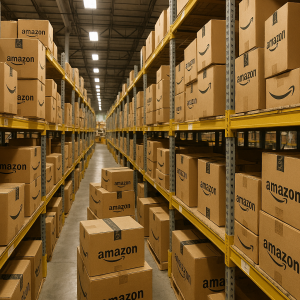You can’t turn anywhere these days without hearing about tariffs.
As of April 2025, the U.S. and China have implemented 100%+ tariffs on each other, with no signs of either side blinking.
But here’s the thing – at The Wholesale Formula, we don’t follow politics closely or take sides.
Full stop.
What do we do? We help keep you prepared for WHATEVER might come your way.
We adjust our businesses based on economic realities.
For Amazon wholesale sellers, these developments create both challenges and opportunities.
While we can’t predict exactly how long these tariffs will remain in place or whether a recession will materialize, one thing is clear: being prepared is better than being caught off guard.
This guide will help you position your Amazon wholesale business to not just survive but potentially thrive during economic uncertainty.
Economic Context & Relevance
How Economic Uncertainty Affects E-commerce and Amazon Selling

The current economic climate presents a complex picture for Amazon sellers. Economic uncertainty indices are at their highest levels since the pandemic, and this uncertainty has real effects on consumer behavior and business operations. For Amazon sellers specifically, tariffs create several immediate challenges:
Higher import costs are squeezing profit margins, particularly for private-label sellers sourcing from Chinese manufacturers. Many sellers are facing difficult decisions about whether to absorb these costs or pass them on to consumers through price increases.
Yet history shows that e-commerce often displays resilience during economic downturns. Some analysts predict Amazon could gain retail market share during this period as consumers hunt for better values and deals online. The platform’s vast selection and competitive pricing become even more attractive when consumers are price-sensitive.
Why Wholesale May Be More Resilient Than Other Amazon Business Models
The wholesale model offers several advantages during economic uncertainty:
- Lower Inventory Risk: Unlike private label, wholesale typically requires smaller initial investments and allows for more agile inventory management.
- Established Brand Demand: You’re selling products that already have market recognition and established demand, reducing the need to build brand awareness during a time when marketing budgets may be tight.
- Supplier Flexibility: Wholesale sellers can more easily pivot between products, categories, and even suppliers as market conditions change.
- Geographic Diversification: Wholesale sellers can often more quickly shift sourcing to different countries to avoid the highest tariffs, compared to private label sellers who may have significant investments in specific manufacturing relationships.
Consumer Behavior Shifts During Recessions
Understanding how consumer priorities change during economic downturns is crucial for Amazon wholesale sellers looking to maintain sales velocity.
How Spending Patterns Change
When economic uncertainty rises, consumer purchasing behavior shifts in predictable ways:
- Essential vs. Discretionary: Consumers prioritize necessities over luxuries. Basic items like toothpaste, deodorant, shampoo, and toilet paper remain in steady demand regardless of economic conditions.
- Trading Down: Shoppers seek less expensive alternatives within categories they still need to purchase. They may switch from premium brands to more affordable options while still purchasing within the same product category.
- Value Redefinition: The perception of “value” changes. Customers place greater emphasis on durability, multi-functionality, and cost-per-use rather than luxury features or status.
Categories That Typically See Growth During Economic Uncertainty
Some product categories actually see increased demand during economic downturns:
- Home Cooking Supplies: As consumers cut back on dining out, kitchenware and cooking essentials often see increased sales.
- DIY and Repair Products: Items that help extend the life of existing possessions become more popular than replacement purchases.
- Affordable Self-Care Items: The “lipstick effect” refers to the historical pattern where even during major downturns like The Great Depression, sales of small affordable luxuries like lipstick increased.
- Home Entertainment: Products that provide entertainment value at home typically perform well when people cut back on outside entertainment expenses.
Resilient Product Selection Framework
Adapting your inventory strategy for economic uncertainty requires a methodical approach to product selection.

Specific Categories That Historically Perform Well in Recessions
Based on historical data, these categories tend to maintain steady demand during economic downturns:
- Personal Care Essentials: Products like toothpaste, soap, shampoo, laundry detergent, dish soap, toilet paper, and paper towels are labeled “consumer staples” because they’re always in demand.
- Basic Food Items: Shelf-stable and essential grocery items typically maintain strong sales.
- Home Cleaning Products: Household cleaning supplies are essential for daily life and often overlooked when people are trying to save money.
- Budget-Friendly Children’s Items: Parents prioritize spending on their children even when cutting back elsewhere.
- Pet Care Products: Pet owners typically maintain spending on their pets regardless of economic conditions.
Price Point Considerations for Recession-Resistant Products
The sweet spot for recession-resistant products typically involves:
- Mid-Range Pricing: Products at extremely high price points face resistance, but the absolute cheapest options may raise quality concerns. Look for established brands with mid-range options.
- Value Pack Opportunities: Products that offer bulk savings or multi-packs often perform well as consumers calculate cost-per-unit more carefully.
- Cost-per-Use Ratio: Items with a lower cost-per-use (like a durable kitchen tool that will be used hundreds of times) maintain appeal even at slightly higher price points.
Diversification Strategies Across Multiple Categories
Retailers with broad and diversified product ranges are typically more recession-resistant as they can meet varied customer needs and adjust their offerings based on changing consumer preferences. Consider these diversification approaches:
- Essential/Discretionary Balance: Maintain a portfolio that includes both recession-resistant essentials and higher-margin discretionary items.
- Cross-Category Hedging: Diversify across categories that respond differently to economic conditions to create natural hedging.
- Price-Tier Coverage: Offer good/better/best options within categories to capture both trading-down and quality-conscious customers.
Marketing and Positioning Adjustments
During economic uncertainty, how you present your products becomes even more important than what you sell.
How to Adjust Product Listings to Emphasize Value
- Highlight Durability and Longevity: Emphasize quality construction and long-term reliability in bullet points and descriptions.
- Feature Multi-Functionality: Showcase how one product can serve multiple purposes, reducing the need for additional purchases.
- Showcase Cost-Effectiveness: Calculate and display the cost-per-use or savings over time compared to alternatives.
- Value-Based Comparisons: Without directly naming competitors, create comparison charts that emphasize your product’s value advantages.
PPC Strategy Changes During Economic Uncertainty
Your advertising approach may need adjustments:
- Focus on Converting Search Terms: Shift budget toward high-intent, transactional keywords rather than broad awareness terms.
- Bid Strategy Adjustments: Industry experts recommend careful monitoring of pricing strategies, as Amazon might suppress the buy box if prices are raised too quickly or too high.
- Essential Category Emphasis: Increase ad spend on your most recession-resistant categories while potentially reducing investment in highly discretionary offerings.
Customer Retention Focus vs. Acquisition
Retailers with strong brand loyalty can remain resilient during a recession, as loyal customers may continue patronizing the brand despite economic challenges. Consider these strategies:
- Post-Purchase Communication: Follow up with buyers to ensure satisfaction and build relationships.
- Repeat Purchase Incentives: Offer loyalty discounts or bundles to encourage existing customers to return.
- Customer Service Excellence: Outstanding service becomes an even stronger differentiator during economic uncertainty.
Preparing Your Business Now
The current tariff situation creates immediate challenges but also potential advantages for prepared Amazon wholesale sellers. As Amazon’s CEO Andy Jassy recently noted, many third-party sellers have flexibility to source products from outside China to avoid the highest tariffs.
By focusing on recession-resistant categories, emphasizing value in your marketing, and diversifying your product mix, you can position your Amazon wholesale business to weather economic uncertainty and potentially gain market share while less-prepared competitors struggle.
Remember, recessions don’t affect all businesses equally.
Those who prepare thoughtfully often emerge stronger when economic conditions improve.
